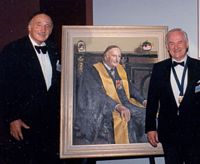


The development of microvascular surgery in Australia
Introduction
Participants
Beginnings
Developing links with academia and hospital medicine
A bevy of supporters
An ever-widening circle of contributors
Building research capacity
Nurturing relationships
Raising funds for research and development
The microsurgeon and the law
Winning community and corporate support
Leadership
The Institute and its style
Endnotes
Index
Search
Help
Contact us

Ann Westmore: Are you saying that Bernard didn't get on with some of the plastic surgeons at other hospitals?
Bryan Egan: I don't think Bernard got on with all the plastic surgeons around Melbourne. Wayne Morrison probably has imbibed, osmotically or otherwise, knowledge which he will not be pouring out before us now. But Bernard and Wayne were so close. If Allan MacLeod were here, for instance, he would know the whole story.
Wayne Morrison: I think it should be said though, that the Melbourne Hospital and St Vincent's historically, a gulf has always been between them. And it’s the extraordinary link with 'Weary’ Dunlop[43], whose portrait is in our board room, who was an inaugural member of our Board, he was virtually the first person from the Melbourne Hospital to ever set foot from Royal Parade. So, I think Bryan, you are right that there were some personality issues. I think they were [between] more than just Bernard and another person. They were historic, they were religious, they were events that were linked to that period and that have taken a long, long time to dissipate.

“Weary” Dunlop and Bernard O’Brien with Dunlop’s portrait. Used with the permission of the Bernard O’Brien Institute of Microsurgery.
Unknown voice: I don't think, irrespective of whether Bernard did get on with individuals in other hospitals, that Bernard would have gone to the Melbourne Hospital.
Wayne Morrison: I don't think that was something that he would really have entertained…Dick do you? I mean historically it was just not done. You were a St Vincent’s boy.
Dick Bennett: I think he was a St Vincent's boy and would have stayed here. Knowing Bernard I think he would have kept on…
Wayne Morrison: …and I think that has a lot to do with the successes of this unit, the Plastic Unit here, it was a very congenial, loyal group that was a team. That's what made this unit at St Vincent’s unique almost worldwide. This loyalty, and sense of belonging as a team. And it’s very difficult to find any surgical unit, of no matter what persuasion, that has genuine loyalty throughout the whole ranks…within the microsurgery area, it did, and that’s largely I think one of its success issues that we all believe for whatever reason.
 |
Witness to the History of Australian Medicine |  |
© The University of Melbourne 2005-16
Published by eScholarship Research Centre, using the Web Academic Resource Publisher
http://witness.esrc.unimelb.edu.au/047.html